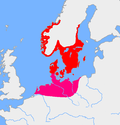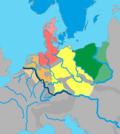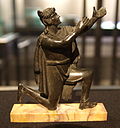The Nordic Indo-Germanic people is a mythological group, from which the Germanic peoples allegedly descended. The assumption of the existence of this primordial...
90 KB (12,025 words) - 21:21, 9 November 2024
counter the denordification of Germans, the main branch of the Nordic Indo-Germanic people. According to Nazi racial theorists such as Hans F. K. Günther...
6 KB (676 words) - 16:20, 26 January 2024
Balto-Slavic, Celtic, Germanic, Hellenic, Indo-Iranian, and Italic; another nine subdivisions are now extinct. Today, the individual Indo-European languages...
112 KB (10,259 words) - 20:13, 21 November 2024
Continental Germanic mythology. It was a key element of Germanic paganism. As the Germanic languages developed from Proto-Indo-European language, Germanic mythology...
9 KB (973 words) - 19:50, 30 July 2024
characters. Proto-Germanic (abbreviated PGmc; also called Common Germanic) is the reconstructed proto-language of the Germanic branch of the Indo-European languages...
130 KB (12,194 words) - 16:22, 22 November 2024
North Germanic peoples, Nordic peoples and in a medieval context Norsemen, were a Germanic linguistic group originating from the Scandinavian Peninsula...
91 KB (10,684 words) - 19:13, 25 October 2024
Germanic peoples. East Germanic is one of the primary branches of Germanic languages, along with North Germanic and West Germanic. The only East Germanic language...
9 KB (918 words) - 21:48, 20 October 2024
The North Germanic languages make up one of the three branches of the Germanic languages—a sub-family of the Indo-European languages—along with the West...
57 KB (5,452 words) - 18:17, 22 September 2024
Anglo-Saxons, Germanic peoples, Balts, Baltic Finns, Northern French, and certain Celts, Slavs and Ghegs. The supposed physical traits of the Nordics included...
27 KB (3,010 words) - 04:04, 13 November 2024
The Germanic parent language (GPL), also known as Pre-Germanic Indo-European (PreGmc) or Pre-Proto-Germanic (PPG), is the stage of the Germanic branch...
11 KB (1,249 words) - 03:56, 16 November 2024
The Indo-European migrations are hypothesized migrations of peoples who spoke Proto-Indo-European (PIE) and the derived Indo-European languages, which...
267 KB (29,498 words) - 03:16, 21 November 2024
refers to the dilution of Aryan, Indo-Germanic Nordic blood by the addition of non-Nordic populations to the Nordic race. Thus, according to Richard Walther...
15 KB (1,846 words) - 17:14, 18 September 2024
The Germanic peoples were tribal groups who lived in Northern Europe in Classical Antiquity and the Early Middle Ages. In modern scholarship, they typically...
164 KB (20,237 words) - 21:00, 21 November 2024
Germanic given names are traditionally dithematic; that is, they are formed from two elements, by joining a prefix and a suffix. For example, King Æþelred's...
59 KB (1,327 words) - 20:38, 24 October 2024
original Indo-Germanic civilisation" was carried by Nordic migrants to India, and that the physiognomies of upper-caste Indians "disclose a Nordic origin"...
67 KB (8,065 words) - 17:12, 11 November 2024
Nazi racial theories (category Nordicism)
with Germanic peoples as representative of Nordic race being best branch, and they considered Jews, mixed-race people, Slavs, Romani, Black People, and...
211 KB (28,239 words) - 19:59, 18 November 2024
Rome. After the Roman Era, seeresses occur in records among the North Germanic people, where they form a reoccurring motif in Norse mythology. Both the classical...
85 KB (11,137 words) - 07:14, 3 November 2024
Germanic paganism or Germanic religion refers to the traditional, culturally significant religion of the Germanic peoples. With a chronological range...
128 KB (15,974 words) - 22:17, 7 November 2024
Pre-Armenian and Pre-Greek (after 2500 BC) Proto-Indo-Iranian (2000 BC) Pre-Germanic and Pre-Balto-Slavic; proto-Germanic (500 BC) David W. Anthony, following the...
128 KB (7,062 words) - 16:34, 15 November 2024
Indo-Aryan peoples are a diverse collection of peoples speaking Indo-Aryan languages in the Indian subcontinent. Historically, Aryans were the Indo-Iranian...
20 KB (1,597 words) - 04:24, 20 November 2024
Battle Axe culture (redirect from Battle axe people)
absorbed, developing into the Nordic Bronze Age. The Nordic Bronze Age has, in turn, been considered ancestral to the Germanic peoples. The Battle Axe culture...
20 KB (2,476 words) - 13:25, 2 May 2024
The West Germanic languages constitute the largest of the three branches of the Germanic family of languages (the others being the North Germanic and the...
56 KB (4,768 words) - 15:41, 5 November 2024
Early Germanic culture was the culture of the early Germanic peoples. The Germanic culture started to exist in the Jastorf culture located along the central...
115 KB (14,632 words) - 21:05, 21 November 2024
The Anatolians were a group of Indo-European peoples who inhabited Anatolia as early as the 3rd millennium BC. Identified by their use of the now-extinct...
11 KB (1,095 words) - 06:39, 3 November 2024
referring to the entirety of their people, whereas the same Proto-Indo-European root (*aryo-) is the basis for Greek and Germanic word forms which seem only to...
54 KB (6,411 words) - 09:32, 18 September 2024
Greek deities to Germanic, Roman, and Celtic deities Neolithic religion Proto-Indo-European society West 2007, p. 2: "If there was an Indo-European language...
141 KB (17,177 words) - 13:17, 12 November 2024
Proto-Indo-European society is the reconstructed culture of Proto-Indo-Europeans, the ancient speakers of the Proto-Indo-European language, ancestor of...
78 KB (9,373 words) - 07:05, 21 October 2024
The Germanic languages are a branch of the Indo-European language family spoken natively by a population of about 515 million people mainly in Europe,...
93 KB (9,521 words) - 22:41, 29 October 2024
Northern Europe Sacred trees and groves in Germanic paganism and mythology Proto-Celtic paganism Proto-Indo-Iranian paganism Koch 2020, p. 139. Koch 2020...
72 KB (1,709 words) - 20:31, 8 July 2024
Norse mythology (redirect from Nordic mythology)
Norse, Nordic, or Scandinavian mythology, is the body of myths belonging to the North Germanic peoples, stemming from Old Norse religion and continuing...
30 KB (3,611 words) - 13:14, 21 November 2024

















